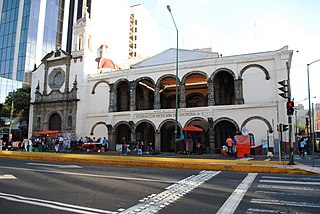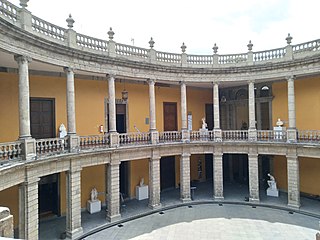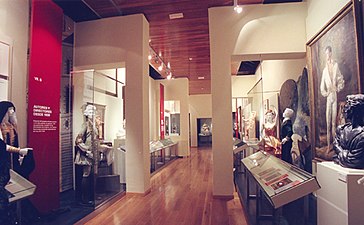
The Museo del Prado, officially known as Museo Nacional del Prado, is the main Spanish national art museum, located in central Madrid. It houses collections of European art, dating from the 12th century to the early 20th century, based on the former Spanish royal collection, and the single best collection of Spanish art. Founded as a museum of paintings and sculpture in 1819, it also contains important collections of other types of works. The numerous works by Francisco Goya, the single most extensively represented artist, as well as by Hieronymus Bosch, El Greco, Peter Paul Rubens, Titian, and Diego Velázquez, are some of the highlights of the collection. Velázquez and his keen eye and sensibility were also responsible for bringing much of the museum's fine collection of Italian masters to Spain, now one of the largest outside of Italy.

Ramón María del Valle-Inclán y de la Peña was a Spanish dramatist, novelist, and member of the Spanish Generation of 98. His work was considered radical in its subversion of the traditional Spanish theatre in the early 20th century. He influenced later generations of Spanish dramatists and is honored on National Theatre Day with a statue in Madrid.

The Palacio de Bellas Artes is a prominent cultural center in Mexico City. This hosts performing arts events, literature events and plastic arts galleries and exhibitions. "Bellas Artes" for short, has been called the "art cathedral of Mexico", and is located on the western side of the historic center of Mexico City which is close to the Alameda Central park.

The National Archaeological Museum is a archaeology museum in Madrid, Spain. It is located on Calle de Serrano beside the Plaza de Colón, sharing its building with the National Library of Spain. It is one of the National Museums of Spain and it is attached to the Ministry of Culture.

José Luis López Vázquez de la TorreMMT was a Spanish actor, comedian, costume designer, scenic designer and assistant director. He was best known internationally for his lead role in the surrealist horror TV film La cabina. A prolific performer, he was an integral part of Spanish cinema for six decades, appearing in almost 250 films between 1948 and 2007.
Gerardo Vera Perales was a Spanish costume and set designer, opera director, actor, and film and theatre director.
António LagartoGOIH is a Portuguese set and costume designer and artist.

Eduardo Arroyo Rodríguez was a Spanish painter and graphic artist. He was also active as an author and set designer. Arroyo is regarded as one of the most important exponents of politically committed realism.
Ernesto de la Cárcova y Arrotea was an Argentine painter of the Realist school.

The Museo de Charrería or Charrería Museum is located in the historic center of Mexico City on Izazaga Street, in an old monastery which was dedicated to the Virgin of Montserrat. The monastery closed in 1821 and the building deteriorated significantly, until it was decided to rehabilitate it as a tourist attraction. The purpose of the museum is to preserve and promote the sport and tradition of the charreada with both the museum's permanent display of art and handicrafts as well as outreach programs.

The Museo de la Estampa is a museum in Mexico City, dedicated to the history, preservation and promotion of Mexican graphic arts. The word “estampa” means works in the various printmaking techniques which have the quality of being reproducible and include seals, woodcuts, lithography and others. The museum was created in 1986 and located in a 19th-century Neoclassical building located in the Plaza de Santa Veracruz in the historic center of the city. This building was remodeled both to house the museum and to conserve its original look.

The Museo Nacional de San Carlos is a Mexican national art museum devoted to European art, located in the Cuauhtémoc borough in Mexico City. The museum is housed in the Palace of the Count of Buenavista, a neoclassical building at Puente de Alvarado No. 50, Colonia Tabacalera, Mexico City. It contains works by Lucas Cranach the Elder, Parmigianino, Frans Hals, Anthony van Dyck, Jean-Auguste-Dominique Ingres, Auguste Rodin and other well-known European painters and sculptors.

Museo Universitario de Artes Populares María Teresa Pomar is a museum dedicated to Mexico's handcrafts and folk art tradition, called “artesanía.” It is part of the University of Colima in the city of Colima, founded by artesanía collector and promoter María Terea Pomar. It contains one of the most important collections of its type in Mexico, covering traditions from around the country as well as the artesanía and traditions of the state of Colima.

The Museo Regional de la Cerámica in Tlaquepaque, Jalisco, Mexico is located on Independencia Street in the center of the city. The museum is one of two main ceramics museums in the city, with the other being the Pantaleon Panduro Museum. It was established in 1954 to preserve and promote indigenous handcrafts of Jalisco, especially the state’s ceramic tradition. The emphasis is still on ceramics but the museum also has a room dedicated to Huichol art and holds events related to various types of indigenous crafts and culture.

The Centre de Documentació i Museu de les Arts Escèniques, also known as MAE, is a centre for information and research on the performing arts in Catalonia, Spain. The centre has an extensive library, an archive and collections from the Institut del Teatre, which specializes in theatre, dance, opera, zarzuela, music hall, magic and circus performances. Its major collections encompass Catalonia and the Spanish Golden Age. The centre also has posters, programmes, photographs, pictures, puppet theatres, set designs and costumes which are exhibited in temporary exhibitions and online, since it has no permanent exhibition space. The museum is a member of SIBMAS and ENICPA, and is part of the ECLAP European Project. In Catalonia, it is involved with the Consortium of Academic Libraries of Catalonia.

The Museo Universitario del Chopo is located at Doctor Enrique González Martínez Street in the Colonia Santa María la Ribera of Mexico City. It has collections in contemporary art, and is part of the National Autonomous University of Mexico (UNAM).

Teatro Español, formerly Teatro del Príncipe and Corral del Príncipe, is a public theatre administered by the Government of Madrid, Spain. The original location was an open-air theatre in medieval times, where short performances and some theatrical pieces, which became part of famous classical literature in later years, were staged. Its establishment was authorized by a royal decree of Philip II in 1565.

Dalila Puzzovio is an Argentine visual artist and fashion designer active during the 1960s. Puzzovio works in the art forms of pop, happening, and conceptual art. Her artistic creativity is credited by Graciela Melgarejo as having paved the way for subsequent Argentine artists and greatly influenced the work they produced.

The Provincial Archaeological Museum of Badajoz or simply the Archaeological Museum of Badajoz is an archaeology museum located in Badajoz, Spain. Owned by the Spanish State, its management has been transferred to the Junta of Extremadura.




















